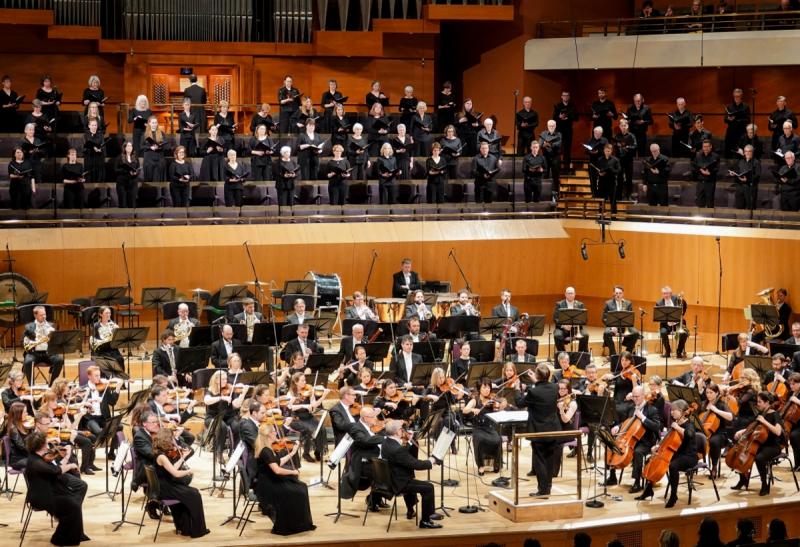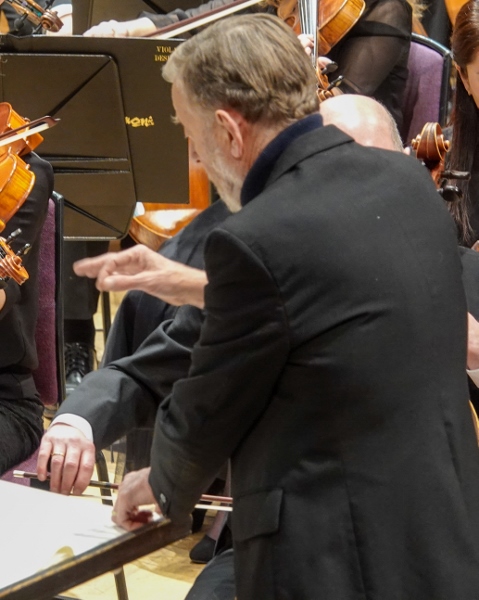Hallé Choir, BBC Philharmonic, Davis, Bridgewater Hall, Manchester review - celebrating Vaughan Williams | reviews, news & interviews
Hallé Choir, BBC Philharmonic, Davis, Bridgewater Hall, Manchester review - celebrating Vaughan Williams
Hallé Choir, BBC Philharmonic, Davis, Bridgewater Hall, Manchester review - celebrating Vaughan Williams
Three big works from the English visionary of the 20th century

Continuing the joint BBC Philharmonic/Hallé celebration of Vaughan Williams, Sir Andrew Davis took on the job of presenting three substantial works on Saturday.
Toward the Unknown Region has given its title to the entire series, not a bad choice of phrase for the career of a composer whose intellectual curiosity and visionary capacity never left him: the phrase is that of the poet Walt Whitman, and the piece itself is a setting of a five-stanza poem for chorus, orchestra and organ.
It's early Vaughan Williams, written when he was working on the music of The English Hymnal, and in many ways it breathes the spirit of Anglican services of Evensong (it even has a bit of the chromatic slither that VW himself dismissed as “like the curate improvising” in reference to another composer). But it’s beautifully and harmoniously written for choir and imaginatively scored, and includes that favourite VW melodic motif most widely known as the opening of his tune to "For all the saints" – in this case blazing out, the first note lengthened, to the words “Then we burst forth”.
 That provides the affirmative, optimistic ending to the piece, which works up to a grand climax near its finish: in effect not quite as rhythmically precise as it might have been at that point, but nonetheless, under direction by Sir Andrew (pictured right), building on beautiful and transparent textures before it, and making considerable impact helped by the resonant boom of the Bridgewater Hall organ (played by Darius Battiwalla).
That provides the affirmative, optimistic ending to the piece, which works up to a grand climax near its finish: in effect not quite as rhythmically precise as it might have been at that point, but nonetheless, under direction by Sir Andrew (pictured right), building on beautiful and transparent textures before it, and making considerable impact helped by the resonant boom of the Bridgewater Hall organ (played by Darius Battiwalla).
Jumping forward in time, the 1930s-written Fourth Symphony came next. With a world war in between, the music is very different from the positivity of the first two symphonies, or even the ambiguously nostalgic aspects of the “Pastoral”. VW himself said it reflected “unbeautiful times”, and its dissonances and nervous energy can hardly be separated from its context of political events in Europe.
This reading drew clear attention to its contrasts of agitation and seemingly unreal calm, such as the concluding bars of the first movement, where the BBC Philharmonic strings, led by Yuri Torchinsky, caught the bitter-sweetness of the moment exactly.
The slow movement (one of Vaughan Williams’ longer ones) brought more of the same eerie peace, and the Scherzo, with clean and disciplined playing on all fronts, was incisive and colourful. The sting in this symphony is in the tail. In some ways it follows the structural model of Beethoven’s Fifth (even using a reiterated drumbeat to transition from the third movement to the finale), but the spirit of its conclusion is miles away from C major optimism. Under Davis’s hands, the brass and wind produced both insinuatingly pleasant oom-pah rhythms and biting stabs as its atmosphere grew heavier and the tone darker.
Job: A Masque for Dancing was a ballet score completed in 1930 (when perhaps the world’s future prospects looked more cheerful than five years later) for Ninette de Valois’ up-and-coming Vic-Wells Ballet, later The Royal. It was written for a large orchestra: first given as a concert piece, it had to be reduced by the company’s Constant Lambert for a theatre-size band, but it sounds vivid, almost film score-like, in its original dress, and ranges through a succession of sound pictures of scenes in the biblical story.
We meet the pastoral/spiritual VW in the opening as well as later, depicting the faithful, prosperous Job before Satan is allowed to get at him, and also in the account of Job’s initial calm acceptance of bad news, but the music for the diabolical antagonist is a precursor of the vicious, heartless sounds in the Fourth Symphony. The impact of “Satan’s Dance” may have been slightly underplayed in its first appearance in Davis’s reading, but the scenes of horror that followed hit home all the more devastatingly soon after.
The shocking episode of Satan usurping God’s throne (introduced to the story by the librettist) brought out graphic effects in the orchestra (with the organ again: deranged baddies always suit a bit of organ tutti), and then Torchinsky’s playing of the almost Lark-like violin solo, representing Elihu, was sweet and lovely. Once right has been restored, with folksong tunes, noble brass and VW-trademark triads of triumph, peace returns – and at the last there was a tantalising fade-out, magically drawn by Davis through to final, breathless silence.
rating
Explore topics
Share this article
The future of Arts Journalism
You can stop theartsdesk.com closing!
We urgently need financing to survive. Our fundraising drive has thus far raised £49,000 but we need to reach £100,000 or we will be forced to close. Please contribute here: https://gofund.me/c3f6033d
And if you can forward this information to anyone who might assist, we’d be grateful.

Subscribe to theartsdesk.com
Thank you for continuing to read our work on theartsdesk.com. For unlimited access to every article in its entirety, including our archive of more than 15,000 pieces, we're asking for £5 per month or £40 per year. We feel it's a very good deal, and hope you do too.
To take a subscription now simply click here.
And if you're looking for that extra gift for a friend or family member, why not treat them to a theartsdesk.com gift subscription?
more Classical music
 Robin Holloway: Music's Odyssey review - lessons in composition
Broad and idiosyncratic survey of classical music is insightful but slightly indigestible
Robin Holloway: Music's Odyssey review - lessons in composition
Broad and idiosyncratic survey of classical music is insightful but slightly indigestible
 Classical CDs: Wolf-pelts, clowns and social realism
British ballet scores, 19th century cello works and contemporary piano etudes
Classical CDs: Wolf-pelts, clowns and social realism
British ballet scores, 19th century cello works and contemporary piano etudes
 Bizet in 150th anniversary year: rich and rare French offerings from Palazzetto Bru Zane
Specialists in French romantic music unveil a treasure trove both live and on disc
Bizet in 150th anniversary year: rich and rare French offerings from Palazzetto Bru Zane
Specialists in French romantic music unveil a treasure trove both live and on disc
 Scottish Chamber Orchestra, Ibragimova, Queen’s Hall, Edinburgh review - rarities, novelties and drumrolls
A pity the SCO didn't pick a better showcase for a shining guest artist
Scottish Chamber Orchestra, Ibragimova, Queen’s Hall, Edinburgh review - rarities, novelties and drumrolls
A pity the SCO didn't pick a better showcase for a shining guest artist
 Kilsby, Parkes, Sinfonia of London, Wilson, Barbican review - string things zing and sing in expert hands
British masterpieces for strings plus other-worldly tenor and horn - and a muscular rarity
Kilsby, Parkes, Sinfonia of London, Wilson, Barbican review - string things zing and sing in expert hands
British masterpieces for strings plus other-worldly tenor and horn - and a muscular rarity
 From Historical to Hip-Hop, Classically Black Music Festival, Kings Place review - a cluster of impressive stars for the future
From quasi-Mozartian elegance to the gritty humour of a kitchen inspection
From Historical to Hip-Hop, Classically Black Music Festival, Kings Place review - a cluster of impressive stars for the future
From quasi-Mozartian elegance to the gritty humour of a kitchen inspection
 Shibe, LSO, Adès, Barbican review - gaudy and glorious new music alongside serene Sibelius
Adès’s passion makes persuasive case for the music he loves, both new and old
Shibe, LSO, Adès, Barbican review - gaudy and glorious new music alongside serene Sibelius
Adès’s passion makes persuasive case for the music he loves, both new and old
 Anja Mittermüller, Richard Fu, Wigmore Hall review - a glorious hall debut
The Austrian mezzo shines - at the age of 22
Anja Mittermüller, Richard Fu, Wigmore Hall review - a glorious hall debut
The Austrian mezzo shines - at the age of 22
 First Person: clarinettist Oliver Pashley on the new horizons of The Hermes Experiment's latest album
Compositions by members of this unusual quartet feature for the first time
First Person: clarinettist Oliver Pashley on the new horizons of The Hermes Experiment's latest album
Compositions by members of this unusual quartet feature for the first time
 Gesualdo Passione, Les Arts Florissants, Amala Dior Company, Barbican review - inspired collaboration excavates the music's humanity
At times it was like watching an anarchic religious procession
Gesualdo Passione, Les Arts Florissants, Amala Dior Company, Barbican review - inspired collaboration excavates the music's humanity
At times it was like watching an anarchic religious procession
 Classical CDs: Camels, concrete and cabaret
An influential American composer's 90th birthday box, plus British piano concertos and a father-and-son duo
Classical CDs: Camels, concrete and cabaret
An influential American composer's 90th birthday box, plus British piano concertos and a father-and-son duo
 Cockerham, Manchester Camerata, Sheen, Martin Harris Centre, Manchester review - re-enacting the dawn of modernism
Two UK premieres added to three miniatures from a seminal event of January 1914
Cockerham, Manchester Camerata, Sheen, Martin Harris Centre, Manchester review - re-enacting the dawn of modernism
Two UK premieres added to three miniatures from a seminal event of January 1914

Add comment